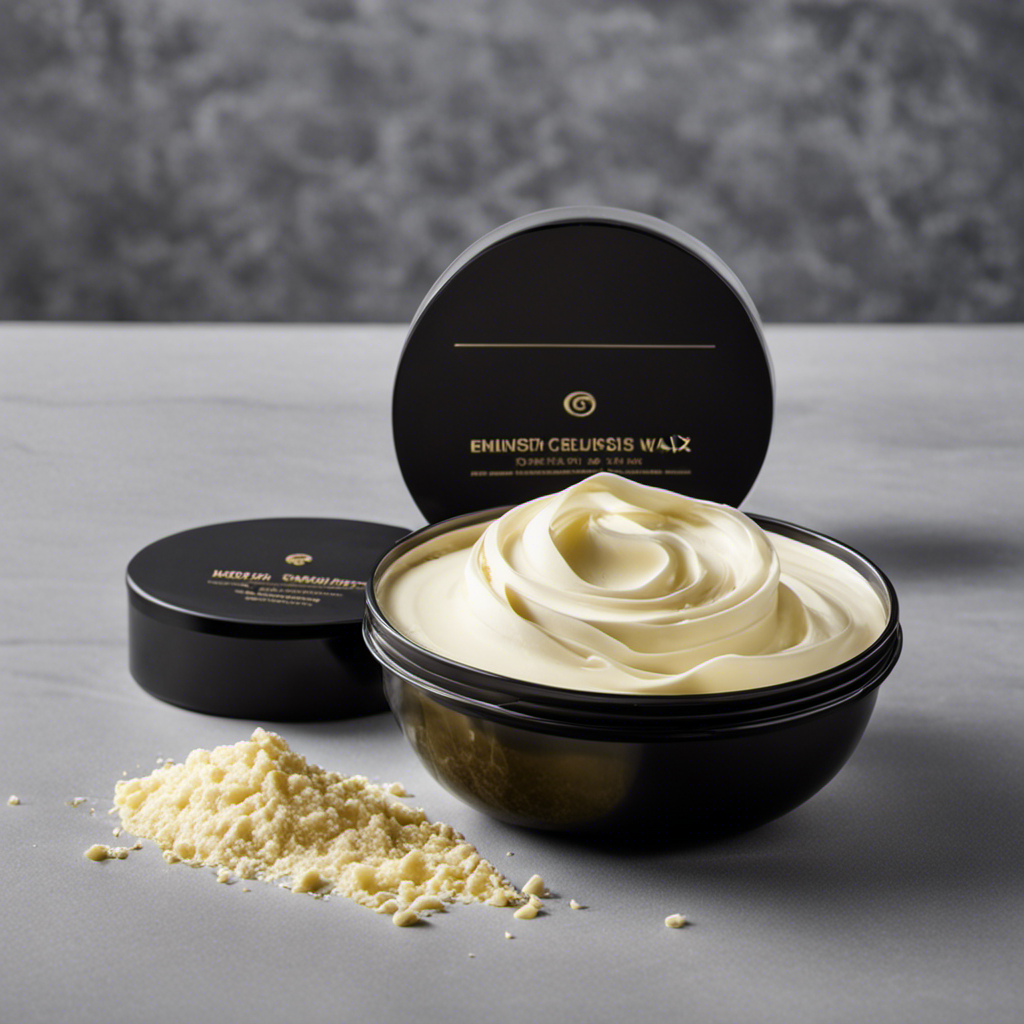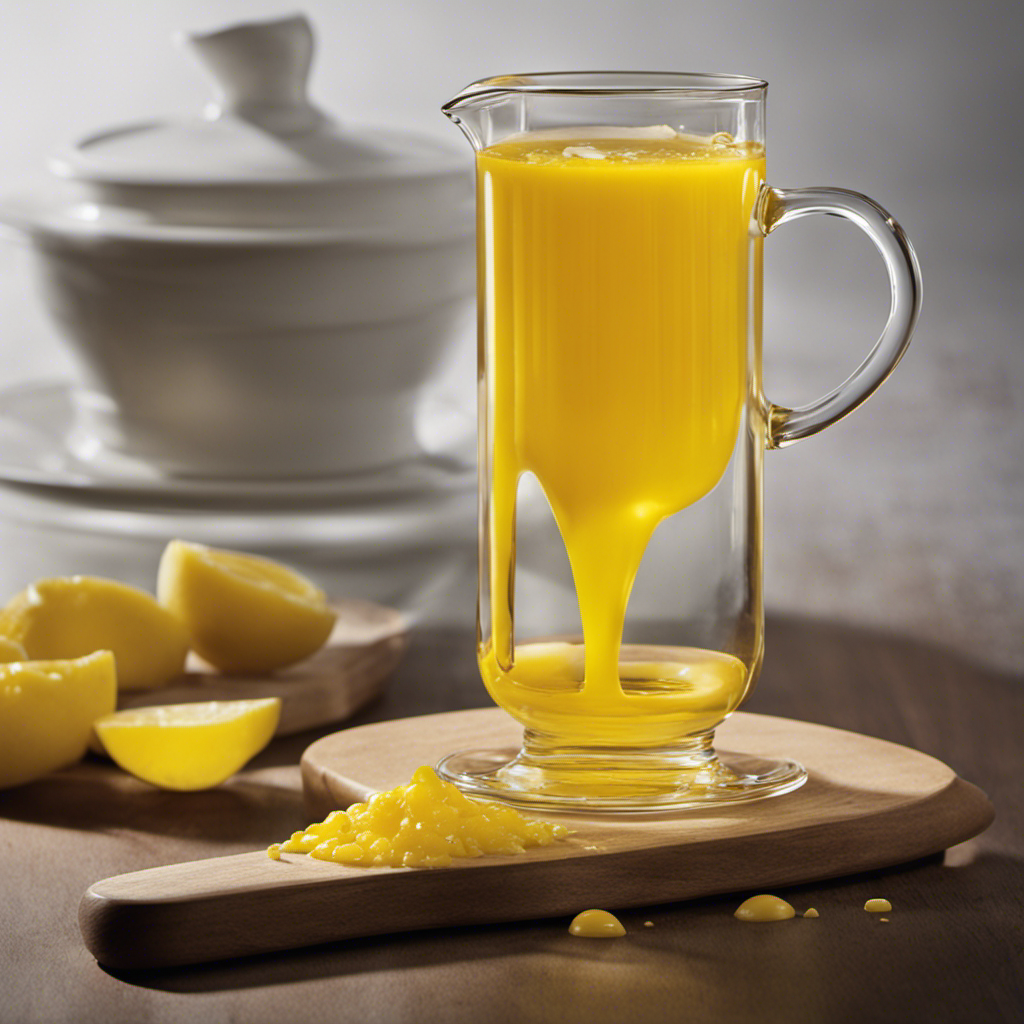I have frequently contemplated the fat content found in a stick of butter. While it is a key ingredient in almost all of my cooking, I have never taken a moment to think about its nutritional information.
Well, today, we’re going to dive deep into the world of butter fat. We’ll explore its composition, its role in cooking and baking, and even its health implications.
So, get ready to be amazed by the butter fat facts you never knew you needed.
Key Takeaways
- Butter contains a significant amount of saturated fat, which can raise cholesterol levels and increase the risk of heart disease.
- Understanding the fat content in butter is important for making informed dietary choices and promoting better heart health.
- Choosing healthier alternatives like olive oil or avocado can be advisable, as they contain healthier fats.
- Butter has a higher fat content compared to most cooking oils, and considering healthier cooking oil options is important for overall health.
Importance of Understanding Butter Fat Content
You need to understand the importance of knowing the fat content in a stick of butter.
Dietary fat plays a crucial role in our overall health. While we often associate fat with weight gain, it is essential for our body to function properly.
However, it is important to be mindful of the type and amount of fat we consume. Butter, a common ingredient in many dishes, contains saturated fat, which can raise cholesterol levels if consumed in excess.
High cholesterol levels can lead to an increased risk of heart disease and other health issues. Therefore, being aware of the fat content in a stick of butter helps us make informed decisions about our dietary choices, ultimately contributing to better heart health.
The Composition of a Stick of Butter
When it comes to understanding the composition of a stick of butter, there are three key points to consider: the fat content breakdown, the nutritional value overview, and comparisons to other fats.
By breaking down the fat content, we can gain a better understanding of the types of fats present in butter and their potential impact on our health.
Additionally, examining the nutritional value overview allows us to assess the overall nutrient profile of butter and its potential benefits or drawbacks.
Fat Content Breakdown
The fat content breakdown of a stick of butter can vary depending on the brand and type. It is important to analyze the fat content of butter as it can have a significant impact on our dietary choices.
On average, a stick of butter contains around 11 grams of saturated fat, which is about 55% of the daily recommended intake. Saturated fats are known to increase cholesterol levels in the blood and can contribute to heart disease.
Therefore, it is recommended to consume butter in moderation and opt for healthier alternatives like olive oil or avocado. By being aware of the fat content in butter, we can make informed choices about our diet and promote better health outcomes.
Nutritional Value Overview
For a quick overview of its nutritional value, it’s helpful to look at the breakdown of fat, protein, and carbohydrates in a stick of butter.
When it comes to fat content, a stick of butter typically contains around 11 grams of saturated fat, which can have implications for our dietary fat intake. Saturated fat has been linked to an increased risk of heart disease, so it’s important to consume it in moderation.
In terms of protein and carbohydrates, butter contains negligible amounts of both. This means that the primary nutritional value of butter comes from its fat content.
When incorporating butter into our diets, it’s crucial to consider the overall balance of fats we consume and to make informed choices that align with our dietary goals.
Comparisons to Other Fats
Comparing butter to other fats, it’s interesting to see how the nutritional profiles differ.
When it comes to fat content, butter is quite high. It contains about 80% fat, with most of it being saturated fat.
This is significantly higher compared to other fats like olive oil or avocado, which have lower saturated fat content and higher amounts of heart-healthy monounsaturated fats.
In terms of dietary fat recommendations, experts recommend limiting saturated fat intake to reduce the risk of heart disease. This means that while butter can be enjoyed in moderation, it’s important to consider healthier fat options as well.
Incorporating a variety of fats into our diet can help us meet our nutritional needs while maintaining a balanced and healthy lifestyle.
The Role of Fat in Butter
When it comes to butter, one of the key points to consider is its fat content. Understanding the amount of fat in butter is important for those who are conscious of their dietary intake.
Additionally, it is worth exploring the health benefits that come with consuming fats, as they play a crucial role in our overall well-being.
Lastly, delving into the role of fat in culinary applications can shed light on why butter is a staple ingredient in many delicious dishes.
Fat Content in Butter
The fat content in a stick of butter can vary depending on the brand. On average, a stick of butter contains about 11 grams of saturated fat. Saturated fat is known to have a negative impact on weight gain and overall health.
It is recommended to limit the consumption of saturated fats to maintain a healthy weight. However, it’s important to note that not all fats are created equal. Butter also contains small amounts of monounsaturated and polyunsaturated fats, which are considered healthier options.
Moderation is key when it comes to consuming butter and other high-fat foods. It’s advisable to choose healthier alternatives like olive oil or avocado as a substitute for butter in certain recipes to reduce overall fat intake.
Health Benefits of Fat
Contrary to popular belief, not all fats are harmful to our health. In fact, certain types of fats can actually be beneficial and essential for our well-being.
While it is true that some fats, like trans fats and saturated fats, can increase the risk of heart disease and other health issues, there are healthier fats that have been shown to have positive effects on our bodies. Unsaturated fats, such as monounsaturated and polyunsaturated fats, can help lower bad cholesterol levels, reduce inflammation, and support brain function.
Including these healthier fats in our diet, found in foods like avocados, nuts, and fatty fish, can have a positive impact on our overall health.
Current dietary recommendations emphasize the importance of consuming these healthier fats in moderation as part of a balanced diet to promote optimal health and reduce the risk of chronic diseases.
Role in Culinary Applications
Including healthier fats in our diet can enhance the flavor and texture of culinary dishes. When it comes to culinary applications, understanding the fat content breakdown is essential. Here are five key points to consider:
-
Extra virgin olive oil: Known for its rich flavor and health benefits, this oil is a great choice for sautéing, dressing salads, and drizzling over cooked dishes.
-
Avocado: Its creamy texture and high monounsaturated fat content make it a perfect addition to smoothies, salads, and spreads.
-
Coconut oil: With its high smoke point, it is suitable for high-heat cooking methods like stir-frying and baking. It adds a delicious tropical flavor to dishes.
-
Nuts and seeds: These provide a satisfying crunch and are a great source of healthy fats. They can be sprinkled on salads, added to granola, or used in nut butters.
-
Fatty fish: Salmon, mackerel, and sardines are rich in omega-3 fatty acids, which are beneficial for heart health. They can be grilled, baked, or pan-seared for a flavorful meal.
Comparing Butter Fat Content to Other Cooking Oils
Did you know that butter typically has a higher fat content compared to most cooking oils?
While butter is made up of about 80% fat, cooking oils like olive oil or canola oil have a lower fat content, usually around 100% fat.
This difference in fat content can have implications for our health. Consuming too much saturated fat, which is found in higher amounts in butter, can increase the risk of heart disease and high cholesterol levels.
On the other hand, cooking oils that are higher in unsaturated fats, like olive oil, can have potential health benefits such as reducing inflammation and improving heart health.
It’s important to be mindful of the fat content in our cooking choices and opt for healthier options when possible.
Health Implications of Consuming Butter Fat
You should be mindful of the health implications of consuming butter due to its higher fat content. Butter is delicious and adds richness to dishes, but it’s important to consider the potential health risks. Here are some key points to keep in mind:
- Butter is high in saturated fat, which has been linked to an increased risk of heart disease.
- Consuming too much saturated fat can raise cholesterol levels and contribute to weight gain.
- Dietary recommendations suggest limiting saturated fat intake to reduce the risk of chronic diseases.
- It’s important to balance your fat intake by incorporating healthier fats like olive oil or avocado into your diet.
- Moderation is key when it comes to consuming butter, so enjoy it in small amounts.
Understanding the health risks associated with butter fat can help you make informed dietary choices. Now, let’s explore how butter fat affects baking and cooking.
How Butter Fat Affects Baking and Cooking
When baking or cooking, it’s important to consider how butter fat affects the texture and flavor of your dishes. Butter fat plays a crucial role in both pastries and sauces.
In pastries, the butter fat contributes to the flakiness and tenderness of the dough. It helps create those beautifully layered pastries that we all love.
In sauces, butter fat adds richness and creaminess, enhancing the overall taste and mouthfeel. The higher the butter fat content, the richer the flavor and the smoother the texture.
However, it’s essential to choose the right butter fat content based on your needs. In the next section, I will provide tips on how to select the appropriate butter fat content for different recipes and preferences.
Tips for Choosing the Right Butter Fat Content for Your Needs
It’s important to consider your needs and preferences when choosing the right butter fat content for your recipes. Different types of butter fat can affect the taste, texture, and overall outcome of your dishes. Here are some tips to help you make the best choice:
-
Unsalted Butter: This type of butter has a higher butter fat content, typically around 82-84%. It is perfect for baking and gives you more control over the saltiness of your recipes.
-
Salted Butter: With a slightly lower butter fat content, around 80%, salted butter adds a touch of flavor to your dishes. It is great for spreading on bread or melting over vegetables.
-
European-Style Butter: This butter has a higher butter fat content, around 82-86%, and a rich, creamy taste. It is ideal for pastries, where a flaky texture is desired.
-
Whipped Butter: Whipped butter has air incorporated into it, resulting in a lighter texture. It has a similar butter fat content to regular butter, around 80%.
-
Clarified Butter: Also known as ghee, clarified butter has a higher butter fat content, around 99%. It is perfect for high-heat cooking, as it has a higher smoke point.
Consider these different types of butter fat when choosing the right one for your needs.
Frequently Asked Questions
Can I Substitute Butter With Other Cooking Oils in a Recipe?
Sure, you can substitute butter with other cooking oils in a recipe. There are many options like olive oil, coconut oil, or canola oil. Keep in mind that each oil has its own flavor differences.
How Does Butter Fat Content Affect the Texture of Baked Goods?
Butter fat content plays a crucial role in the texture of baked goods. Higher fat content results in a tender and moist texture, while lower fat content can lead to a drier and crumbly texture.
What Are the Health Risks Associated With Consuming High Amounts of Butter Fat?
Consuming high amounts of butter fat can increase the risk of heart disease and obesity. It is important to be mindful of our recommended dietary intake and opt for healthier fats with more health benefits.
Are There Any Alternative Options for Individuals Who Are Lactose Intolerant or Have Dairy Allergies?
There are plenty of dairy-free butter alternatives for those with lactose intolerance or dairy allergies. One option is to use lactose-free cooking oils, which can provide a similar texture and taste in recipes.
Does the Type of Cow or Animal Affect the Fat Content in Butter?
Cow genetics and butter production methods can influence the fat content in butter. Different breeds of cows have varying fat percentages in their milk, while production methods like churning affect the final fat content in butter.
Conclusion
After diving into the topic of butter fat content, I’m amazed at how much I’ve learned.
Understanding the fat content in a stick of butter is crucial for both health and cooking purposes. It’s like having a compass to navigate through the world of culinary delights.
Just as a painter needs different brushes, we need to choose the right butter fat content for our needs.
So remember, knowledge is power, and knowing the fat content in your butter is like having a key to unlock a world of delicious possibilities.










